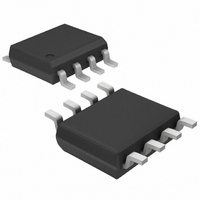MAX9005ESA+T Maxim Integrated Products, MAX9005ESA+T Datasheet - Page 13

MAX9005ESA+T
Manufacturer Part Number
MAX9005ESA+T
Description
IC OP AMP LP HI SPEED 8-SOIC
Manufacturer
Maxim Integrated Products
Type
Amplifier, Comparatorr
Datasheet
1.MAX9002EUA.pdf
(20 pages)
Specifications of MAX9005ESA+T
Applications
General Purpose
Mounting Type
Surface Mount
Package / Case
8-SOIC (3.9mm Width)
Lead Free Status / RoHS Status
Lead free / RoHS Compliant
The common-mode input range extends from 150mV
below the negative rail to within 1.1V of the positive rail.
The bipolar differential inputs of the comparator feature
high input impedance and low input bias currents. The
comparators are designed to maintain low offset volt-
age over the entire operating-temperature, common-
mode, and supply-voltage ranges. In the MAX9000/
MAX9003, the comparator’s inverting input is internally
connected to the reference output.
The CMOS output stage achieves true rail-to-rail opera-
tion; the outputs swing to within a few millivolts of the
supply rails. The comparator’s propagation delay is
185ns and is a function of the overdrive (see Typical
Operating Characteristics ). TTL/CMOS compatibility is
maintained even with a ±4mA output load. A propri-
etary design of the output stage substantially reduces
the cross-conduction current during output transitions,
thereby minimizing power-supply glitches typical of
most comparators. In addition, the comparator’s ±2mV
of built-in hysteresis provides noise immunity and pre-
vents unstable outputs even with slow-moving input
signals.
The 1%-accurate, precision 1.230V internal bandgap
reference in the MAX9000/MAX9001/MAX9003/
MAX9004 achieves an 8ppm/°C temperature coefficient
(tempco). The reference can sink or source 1mA of load
current with excellent load regulation. The output typical-
ly changes only 60µV for a 3V change in input voltage
(line regulation). The reference is stable for capacitive
loads up to 100nF.
The MAX9000–MAX9005 offer excellent performance
and low power consumption, and are available in
space-saving µMAX packages. The following section
provides some practical application guidelines.
The MAX9000–MAX9005 operate from a +2.5V to +5.5V
single supply or from ±1.25V to ±2.75V dual supplies.
(In the MAX9000/MAX9001/MAX9003/MAX9004, the
reference voltage is referred to as V
supply operation, bypass the power supply with a
0.1µF capacitor. For dual supplies, bypass each supply
to ground. Bypass with capacitors as close as possible
to the device to minimize lead inductance and noise.
Use a low-inductance ground plane if possible. A print-
ed circuit board with a ground plane is recommended.
Avoid using wire-wrap boards, breadboards, or IC
sockets. For heavy loads at the comparator’s and/or
Applications Information
______________________________________________________________________________________
Op Amp + Comparator + Reference ICs
Low-Power, High-Speed, Single-Supply
Bypassing and Layout
Voltage Reference
SS
Comparator
.). For single-
amplifier’s output, add a 1µF to 10µF power-supply
bypass capacitor.
The device has a high degree of isolation between the
various blocks. To maintain isolation, careful layout is
required. Take special precautions to avoid crossing
signal traces, especially from the outputs to the inputs.
For sensitive applications, shielding might be required.
In addition, stray capacitance may affect the stability
and frequency response of the amplifier. Decrease
stray capacitance by minimizing lead lengths in the
board layout, as well as placing external components
as close to the device as possible.
Driving large capacitive loads can cause instability in
most low-power, rail-to-rail output amplifiers. These
amplifiers are stable with capacitive loads up to 250pF in
their minimum gain configuration. Stability with higher
capacitive loads can be improved by adding an isolation
resistor in series with the op-amp output, as shown in
Figure 2. This resistor improves the circuit’s phase mar-
gin by isolating the load capacitor from the amplifier’s
output. Figures 3 and 4 show the response of the ampli-
fier with and without an isolation resistor, respectively.
The total capacitance at the op amp’s inputs (input
capacitance + stray capacitance) along with large-value
feedback resistors can cause additional poles within the
amplifier’s bandwidth, thus degrading the phase margin.
To compensate for this effect, place a 2pF to 10pF
capacitor across the feedback resistor, as shown in
Figure 5.
Figure 2. Isolation Resistors to Drive Capacitive Loads
R
R
MAX9000
MAX9001
MAX9002
MAX9003
MAX9004
MAX9005
Op-Amp Frequency Stability
R
R
S
S
C
C
LOAD
LOAD
13











